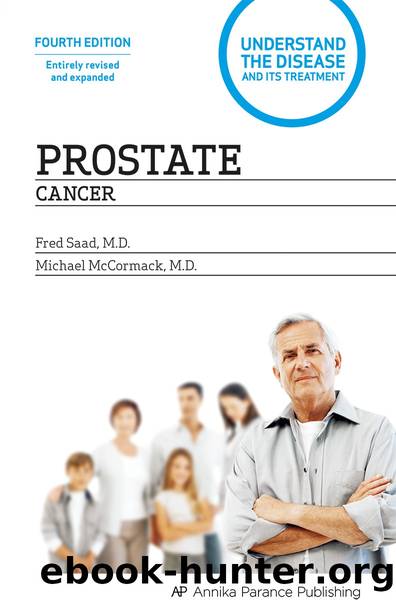Prostate Cancer by Fred Saad

Author:Fred Saad
Language: fra
Format: epub
Tags: Ouvrage de vulgarisation
ISBN: 978-2-923830-27-8
Publisher: Fitzhenry & Whiteside
HORMONE THERAPY
In some cases, hormone therapy is recommended for three to eight months before external beam radiation therapy or brachytherapy to reduce the size of the tumour and make it easier to treat. This is known as neoadjuvant hormone therapy. Some doctors recommend this treatment before radical prostatectomy to make it easier to remove the gland, although this is still an experimental approach and to date has not been demonstrated to increase the chances of cure.
Adjuvant hormone therapy is prescribed after radiation therapy or a radical prostatectomy when, according to the grade and stage of the tumour and PSA levels, it appears that the cancer cells may have spread away from the prostate area. Note that this does not necessarily mean the cancer has metastasized; it may be that the cancer cells were not completely removed at the time of prostatectomy but survived the initial treatment and remained undetected in the body, increasing the risk of recurrence. Hormone therapy is a systemic treatment (i.e., it acts on the entire body) and can treat these cells immediately. It is prescribed for one to three years.
Both neoadjuvant (before radiation therapy/radical prostatectomy) and adjuvant (after radiation therapy/prostatectomy) hormone therapies involve regular injections of LH-RH (luteinizing hormone-releasing hormone) analogs or antagonists. These synthetic compounds imitate naturally produced LH-RH and prevent the testicles from producing testosterone. As testosterone helps cultivate prostate cancer (see Chapter 2), impeding its production reduces the size of the tumour and the prostate gland.
Hormone therapy cannot cure cancer by itself, but it can slow the progression of the disease. In some patients, particularly those with shorter life expectancies, it is the sole treatment.
Hormone therapy as a treatment for localized prostate cancer began only in the 1990s. Because it is so new, there is still no clear consensus regarding its optimal use. The only thing that has been clearly established is that it is recommended for locally advanced cancers (stage T3 tumours scoring 8 or more on the Gleason scale and PSA levels of 20 ng/mL or more) in conjunction with radiation therapy. The data available on other types of cases, however, are not clear enough for doctors to determine the therapy’s effectiveness or to ascertain which patients should receive it, when it should be prescribed or for how long. Without this basic framework, doctors have only their individual judgment to rely on. It is very likely, however, that there will be some progress in this field over the next few years.
If nodal metastasis exists (discovered during surgery or suspected using the Partin tables), radical prostatectomy or radiation therapy is usually not enough, and long-term hormone therapy is indicated to control the disease throughout the entire body (see Chapter 5).
Download
This site does not store any files on its server. We only index and link to content provided by other sites. Please contact the content providers to delete copyright contents if any and email us, we'll remove relevant links or contents immediately.
The Sprouting Book by Ann Wigmore(3558)
Better Homes and Gardens New Cookbook by Better Homes & Gardens(3546)
Trullo by Tim Siadatan(3397)
Super Food Family Classics by Jamie Oliver(3383)
Hedgerow by John Wright(3312)
Panini by Carlo Middione(3283)
Bread Revolution by Peter Reinhart(3098)
Sauces by James Peterson(3070)
Jam by Jam (epub)(3047)
Ottolenghi - The Cookbook by Yotam Ottolenghi(2892)
Oh She Glows Every Day by Angela Liddon(2747)
My Pantry by Alice Waters(2573)
Hot Sauce Nation by Denver Nicks(2465)
The Culinary Herbal by Susan Belsinger(2450)
Veg by Jamie Oliver(2445)
Wanderlust by Jeff Krasno(2237)
Meathooked by Marta Zaraska(2237)
The Art of Making Gelato by Morgan Morano(2232)
Basic Illustrated Edible and Medicinal Mushrooms by Jim Meuninck(2197)
